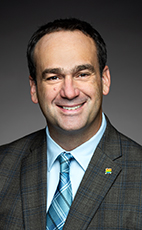Question No. 1748—
Questioner: Heather McPherson
With regard to the government’s participation in negotiations for a pandemic instrument or treaty: (a) what is Canada’s current position on the pandemic treaty, specifically with regard to equitable access to medical countermeasures such as drugs and vaccines, in particular (i) why Canada has proposed that technology transfers to enable other countries to manufacture their own drugs and vaccines only occur on “voluntary and mutually agreed terms” with pharmaceutical companies, even when those drugs and vaccines were developed with public funding from the government, (ii) what Canada proposes to do in situations where pharmaceutical companies do not enter into voluntary agreements, as it frequently did not happen during the COVID-19 pandemic and previous global public health crises such as HIV, (iii) how will Canada ensure that investments of public funds, including those by Canadian taxpayers, in pharmaceutical research, development, and manufacturing, delivers affordable and globally-accessible drugs, vaccines, and other health technologies to Canadians and people worldwide; (b) how is the government implementing the recommendations from the Standing Committee on Foreign Affairs and International Development vaccine equity report entitled “Overcoming the Barriers to Global Vaccine Equity and Ending the Pandemic” during its participation in negotiations for the pandemic instrument, and will the government follow the report’s recommendation 8 that it “ensure that its agreements to provide research and development funding include clauses that allow intellectual property resulting from that funding – including vaccines, therapeutics, and diagnostics – to be easily licensed to manufacturers serving low- and middle income countries”;
(c) how are the positions articulated by civil society during the Pandemic Instrument Partner and Stakeholder Engagement Forum reflected in Canada’s own positions in negotiation of the pandemic instrument; (d) which of the strategies and actions recommended by participants and contained in the government’s report on the Pandemic Instrument Partner and Stakeholder Engagement Forum does the government agree with; (e) which of the strategies and actions recommended by participants and contained in the government’s report on the Pandemic Instrument Partner and Stakeholder Engagement Forum does the government disagree with and why; and (f) how many meetings, emails and phone calls, and on what dates, have officials from (i) Global Affairs Canada, (ii) the Public Health Agency of Canada, (iii) Health Canada, (iv) the Privy Council Office, (v) Public Services and Procurement Canada, (vi) Innovation, Science and Economic Development Canada, (vii) the Office of the Prime Minister, had with (A) Innovative Medicines Canada, (B) pharmaceutical company representatives, (C) Canadian and international not-for-profit or charitable organizations, on the subject of pandemic instrument and the revision of the International Health Regulations?
Question No. 1749—
Questioner: Heather McPherson
With regard to the government’s procurement of vaccines during the COVID-19 pandemic: (a) what price did Canada negotiate per vaccine from each manufacturer, and what was the final price paid per vaccine for each manufacturer; (b) what were the amounts, in Canadian dollars, broken down by vaccine product and company, of advance payments made by the government to pharmaceutical companies to guarantee vaccine shipments; (c) what confidentiality and indemnification clauses did Canada agree to in order to exempt companies from legal liability; (d) were pharmaceutical companies exempted from the obligation to give full refunds if deliveries were delayed or cancelled; (e) what clauses, if any, did the vaccine purchase contracts signed by Canada include relating to the ability of Canada to donate vaccine doses from those contracts to low- and middle-income countries, humanitarian organizations, Gavi, the World Health Organization, or any other organization for use outside of Canada;
(f) when Canada’s Chief Public Health Officer indicated, in October 2021, that initial agreements between Canada and the manufacturers of mRNA vaccines (e.g. Moderna and Pfizer/BioNTech) did not allow for doses to be donated but that new arrangements had been made to permit donations, what were the original conditions and the subsequently agreed conditions, respectively; (g) what is the total value, in Canadian dollars, of funding provided by the government, broken down by department or agency, to support the research, development, or manufacture of vaccines, drugs, or diagnostic tests for COVID-19 between 2020 and 2023; (h) for any of the funding provided during this time to companies, universities, not-for-profits, or other research, development, or manufacturing entities, did any of the funding agreements or contracts contain clauses or stipulations that would secure a pricing structure for the final product for Canadians or for people living in low- and middle-income countries; (i) did Canada attempt to use its leverage as an investor in these technologies to secure fair or affordable pricing of the final products for Canadians or for people living in low and middle income countries; and (j) did Canada attempt to use its leverage as an investor in these technologies to ensure access to the final products for Canadians or for people living in low and middle income countries, for example by requiring the products to be registered for use in Canada or in low and middle income countries?
Question No. 1750—
Questioner: Ed Fast
With regard to Correctional Service Canada: what is the breakdown by security classification of the facility of how many dangerous offenders are currently in each type of facility, including those on parole or conditional release?
Question No. 1751—
Questioner: Ed Fast
With regard to Correctional Service Canada: what is the breakdown by security classification of the facility of how many offenders serving life sentences for multiple murders are currently in each type of facility, including those on parole or conditional release?
Question No. 1752—
Questioner: Ed Fast
With regard to the government’s response to drones being used in the proximity of penitentiaries or other correctional facilities, within the past five years: (a) has the government tested or used technology to jam or nullify mobile phone or drone use in relation to any penitentiary or correctional facility, and, if so, what are the details of what was done, including, for each action, the (i) date, (ii) summary of what was done; and (b) has the government consulted or sought external advice related to the drones being used to smuggle items into penitentiaries or correctional facilities, and, if so, what are the details, including the (i) name of the individual or firm, (ii) date, (iii) value of the contract, if applicable, (iv) description of the parameters for the advice or consultation sought, (v) description of the advice or information received?
Question No. 1754—
Questioner: Dane Lloyd
With regard to the upcoming tenth session of the Conference of the Parties (COP10) to the World Health Organization Framework Convention on Tobacco Control, from November 10 to 25, 2023, and the third session of the Meeting of Parties (MOP3) to the Protocol to Eliminate Illicit Trade in Tobacco Products, from November 27 to 30, 2023: (a) how many individuals will be part of the government's delegation and what are their names and titles; (b) what is the overall budget for the government's COP10 and MOP3 participation, broken down by (i) accommodations, (ii) meals or per diems, (iii) hospitality; (c) what are the government's key priorities or action items for both the COP10 and MOP3; and (d) has the government been assigned any specific agenda items or resolutions for both the COP1O and MOP3, and, if so, what are they?
Question No. 1755—
Questioner: Warren Steinley
With regard to the Canada Child Benefit, during the most recent round of payments: (a) how many and what percentage of families who received payments got (i) the maximum payment amount for each child, (ii) a decreased payment amount due to the adjusted family net income level; and (b) of the families in (a) who received a decreased amount, what was the number and percentage of recipients that had their payments reduced by (i) less than 25 percent, (ii) 25 to 50 percent, (iii) more than 50 percent to 75 percent, (iv) more than 75 percent?
Question No. 1756—
Questioner: Gord Johns
With regard to workplace and work-related injuries in the public sector, broken down by department and fiscal year since 2015-16: (a) what is the total number of public sector workers who experienced (i) physical injuries in the workplace, (ii) injuries to their mental health or mental well-being in the workplace; (b) how many of the workers in (a) experienced injuries that resulted in the worker being unable to work either (i) temporarily, (ii) permanently, (iii) to the full extent of their job duties prior to their injury; (c) how many of the workers in (a) experienced injuries that resulted in a leave of work of (i) less than one month, (ii) one to three months, (iii) three to six months, (iv) six to 12 months, (v) 12 months or more; (d) of the workers who experienced injuries in (a), how many saw reduced or modified job duties for (i) less than one month, (ii) one to three months, (iii) three to six months, (iv) six to 12 months, (v) more than 12 months; and (e) how many workers in (a) were (i) permanently unable to work, (ii) unable to work in the same role, (iii) required to change work place or job title?
Question No. 1759—
Questioner: Frank Caputo
With regard to contraband items seized in federal penitentiaries, broken down by year for each of the last five years: what is the breakdown of the items seized, including the volume of each type of item seized, in total and broken down by correctional institution?
Question No. 1760—
Questioner: Arpan Khanna
With regard to the government’s response to drug addiction: (a) what are the government’s estimates on the number of Canadians who are addicted to illicit drugs, broken down by substance; (b) for each substance in (a), what is the government’s strategy to get those addicted into treatment and recovery, or to otherwise stop the addiction; (c) how much funding is being provided for the treatment and recovery strategy, broken down by year for the next five years; and (d) what are the government’s targets on how many fewer people will be addicted to each substance in (a), broken down by substance and year for the next five years?
Question No. 1761—
Questioner: Colin Carrie
With regard to Health Canada and the Public Health Agency of Canada: (a) was each COVID-19 vaccine approved for use in Canada tested for safety against placebo prior to licensing, and, if not, which ones were exempted from the testing and why; (b) what specific ongoing studies and clinical trials is the government monitoring to compare the COVID vaccines against placebo, and what are the citations for each clinical trial; (c) which studies is the government monitoring to determine all-cause mortality after vaccination for COVID-19 and if there are any findings of correlation or causation as it relates to the COVID-19 vaccination campaign; and (d) what are the citations for each study in (c)?
Question No. 1763—
Questioner: Adam Chambers
With regard to the Canada Revenue Agency (CRA) and CRA call centre operations, broken down by fiscal year from 2015-16 to 2023-24: (a) what was, or is, the total budget for all CRA call centre operations; (b) what was, or is, the total employee count for all CRA call centre operations; (c) for each 1-800 number which Canadians can use to call the CRA, broken down by number, (i) how many calls were received, (ii) what was the average wait time or time on hold for callers to speak to a CRA call centre agent, (iii) what was the wait time service standard, (iv) what is the number of calls that were still being blocked or receiving busy signals in the manner noted in the 2017 Fall Reports of the Auditor General of Canada to the Parliament of Canada, entitled “Report 2—Call Centres—Canada Revenue Agency”; (d) for which 1-800 numbers is the call centre system able to record calls; (e) what studies have been conducted, using a random sample of CRA call centre agents from across the country, to effectively and independently measure the percentage of accurate responses provided by CRA call centre agents; and (f) for each study in (e), (i) who conducted the study, (ii) what questions were asked, (iii) what were the results, including the numbers and percentage of inaccurate responses by CRA call centre agents to each question and 1-800 number?
Question No. 1764—
Questioner: Tracy Gray
With regard to expenditures related to the Cabinet retreat which took place in Charlottetown, Prince Edward Island, from August 21 to 23, 2023: (a) what are the total expenditures related to the retreat; (b) what is the breakdown of the expenditures by type of expense (accommodation, hospitality, audio-visual, etc.); and (c) what are the details of all expenditures in excess of $1,000, including, for each, the (i) amount, (ii) vendor, (iii) description of the goods or services provided?
Question No. 1765—
Questioner: Marty Morantz
With regard to all memorandums, briefing notes, and other documents sent from or received by the Privy Council Office related to, or which mention in any way, Ukrainian President Volodymyr Zelenskyy's visit to Parliament on September 22, 2023: what are the details of each, including the (i) date, (ii) sender, (iii) recipient, (iv) type of document, (v) title, (vi) summary of the contents, (vii) file number?
Question No. 1767—
Questioner: Chris Lewis
With regard to all memorandums, briefing notes, and other documents sent from or received by Global Affairs Canada related to, or which mention in any way, Ukrainian President Volodymyr Zelenskyy's visit to Parliament on September 22, 2023: what are the details of each, including the (i) date, (ii) sender, (iii) recipient, (iv) type of document, (v) title, (vi) summary of the contents, (vii) file number?
Question No. 1772—
Questioner: Matthew Green
With regard to the government’s Directive on Automated Decision-Making, since March 4, 2019, broken down by department or agency: (a) did the department conduct any algorithmic impact assessments; (b) what was the conclusion of each assessment in (a), including the (i) information technology or automated decision system assessed, (ii) date the assessment was completed, (iii) impact assessment level results; (c) does the department currently license, subscribe to, or otherwise procure services from an entity that provides artificial intelligence or automated decision-making services; (d) what are the details of all procurement contracts in (c), including the (i) name of the company contracted, (ii) name of the product provided, (iii) amount paid by the department or agency; (e) was the department or any individuals within the department found in non-compliance with the directive; and (f) what consequences were applied for each instance in (e)?
Question No. 1773—
Questioner: Michelle Rempel
With regard to the government’s consultations on a generative artificial intelligence code of conduct since August 1, 2023: (a) how many consultations has the government held on this proposal; (b) how many stakeholders has the government consulted with on this proposal; (c) what are the details of the consultations, including, for each, the (i) names of the organizations consulted, (ii) date, (iii) outcome, recommendation or feedback; (d) what is the total cost of all consultations which have occurred to date; (e) what is the breakdown of (d) by date and line item; (f) have any outside consultants or service providers been involved in the development of this policy and any related consultations, and, if so, what are the details of each consultant or service provider's involvement, including the (i) name of the individual or firm, (ii) contract value, (iii) date of the contract, (iv) description of the goods or services provided; (g) what are all specific concerns that have been raised to date in the consultations; (h) how many government employees or full-time equivalents have worked on the consultations; (i) what are the travel costs associated with the consultations incurred to date (i) in total, (ii) broken down by year and type of expense; and (j) what is the current status of this policy proposal?
Question No. 1774—
Questioner: Michelle Rempel
With regard to the use of facial recognition software by the government since November 4, 2015: (a) which departments, agencies, Crown corporations, or other government entities use facial recognition software, and, for each one that uses the software, what is the (i) stated purpose, (ii) scope of use; (b) what ethical implications and concerns has the government sought to mitigate in its use of facial recognition within any government department or agency; (c) how has the government sought to mitigate each of the implications and concerns in (b); and (d) what measures has the government put in place to address algorithmic issues and racial profiling in its use of facial recognition software?
Question No. 1775—
Questioner: Michelle Rempel
With regard to any spending by any department, agency, or other government entity for receptions, trade shows, fairs or festivals held outside of Canada since January 1, 2016, broken down by year: (a) how many receptions, trade shows, fairs or festivals held overseas has the government funded; (b) what are the names and dates of all international festivals, international fairs or trade shows held overseas that the government has spent money on; (c) what are the details of each event in (b), including, for each, the (i) total spendings by the federal government on the event, (ii) rationale for the funding, (iii) breakdown of what the funds were spent on; and (d) what was the total funding for festivals, international fairs or trade shows held overseas by the government since 2016, broken down by year?
Question No. 1776—
Questioner: Kerry-Lynne D.
With regard to the government’s safe supply initiative: (a) how much (i) heroin, (ii) crack cocaine, (iii) cocaine, (iv) fentanyl, (v) methamphetamine or crystal methamphetamine, (vi) other substance, broken down by type, does the government estimate was distributed as part of safe supply, in total and broken down by year since 2018; and (b) what is the breakdown of (a) by province or territory?
Question No. 1782—
Questioner: Branden Leslie
With regard to the seizure of drugs by the Canada Border Services Agency since January 1, 2022, broken down by month and by type of drug: (a) what is the quantity of drugs that was seized; (b) how many shipments were seized; and (c) what is the breakdown of (a) and (b) by country of origin, or suspected country of origin?
Question No. 1783—
Questioner: Earl Dreeshen
With regard to media reports that the Minister of Environment and Climate Change and his exempt staff incurred more than $700,000 in travel expenses last year: what are the estimated carbon emissions from this travel?
Question No. 1787—
Questioner: Cheryl Gallant
With regard to the Protecting Canadians from Unsafe Drugs Act (Vanessa's Law): (a) has Health Canada published the reports of serious adverse drug reactions from each Canadian hospital, either monthly or annually, to alert doctors and patients of which hospital is in breach of the act, and, if not, why not; (b) how many meetings have Health Canada officials had with drug makers or their representatives since Vanessa’s Law received royal assent in November 2014, related to the implementation of measures in the act; (c) what are the details of each meeting in (b), including, for each, the (i) date, (ii) attendees, (iii) topics discussed, (iv) type and purpose of the meeting; (d) what is the position of Health Canada regarding hospitals which have either not been reporting or underreporting serious adverse drug reactions since the regulations were enacted in 2019; (e) what specific actions, if any, did Health Canada take or is taking to ensure that hospitals comply with Vanessa’s Law; (f) what is the date of each action in (e); (g) how did Health Canada use the information on adverse drug reactions collected from hospitals to take the regulatory actions prescribed in Vanessa’s Law, broken down by drug; and (h) what are the details of all regulatory actions taken in (g), including, for each, the (i) date, (ii) drug, (iii) summary of the actions taken?
Question No. 1788—
Questioner: Philip Lawrence
With regard to Sustainable Development Technology Canada (SDTC): (a) what are the details of all funding which SDTC provided to businesses since January 1, 2020, including, for each, the (i) recipient, (ii) date, (iii) amount, (iv) type of funding (loan, grant, etc.), (v) purpose of the funding; and (b) for each loan in (a), how much has been repaid?
Question No. 1795—
Questioner: Gary Vidal
With regard to items and services funded by Indigenous Services Canada under Jordan’s Principle since 2016, broken down by funding stream: (a) what are the details of all funding provided, including, for each, the (i) date, (ii) amount, (iii) recipient, (iv) description of the items or services; and (b) what was the total amount spent per year under Jordan’s Principle?
Question No. 1796—
Questioner: Louise Chabot
With regard to Employment and Social Development Canada’s Skills for Success Program and the Training and Tools Stream: (a) what is the total amount granted under this program for the year 2023, and, of this amount, how much has been granted to Quebec-based organizations; (b) of all the projects selected, how many are designed to serve a francophone population or clientele; and (c) what are all the projects selected and the amounts granted for each of them?
Question No. 1797—
Questioner: Gary Vidal
With regard to at-risk pay and performance bonuses for those classified as executive and above at Crown-Indigenous Relations and Northern Affairs Canada, and Indigenous Services Canada, since 2018, broken down by year and by type of job: (a) what specific criteria was used to determine if executives received (i) at-risk pay, (ii) performance bonuses, (iii) neither at-risk pay nor performance bonuses; and (b) what number and percentage of executives received (i) both at-risk pay and performance bonuses, (ii) at-risk pay only, (iii) neither at-risk pay nor performance bonuses?
Question No. 1799—
Questioner: Alexandre Boulerice
With regard to Canada Border Services Agency (CBSA) officers serving the United States—Canada land border: (a) does the government consider the CBSA officers protecting the land border to be public safety officers; (b) what is the number of CBSA officers who have worked at CBSA for (i) under five years, (ii) five to 10 years, (iii) 10 to 15 years, (iv) 15 to 20 years, (v) 20 to 25 years, (vi) more than 25 years; and (c) how many CBSA officers are currently on (i) long-term leave, (ii) administrative leave, (iii) short-term leave, for health and safety reasons?
Question No. 1800—
Questioner: Louise Chabot
With regard to the Canada Summer Jobs program: (a) for each of the 338 federal ridings, (i) how much money, (ii) how many positions, (iii) how many hours of work, were allocated for fiscal year 2023-24; (b) for each of the 338 federal ridings, (i) how much money, (ii) how many positions, (iii) how many hours, were requested for fiscal year 2023-24; (c) for each of the 338 federal ridings, what is the numerical difference between the amount of money requested and the amount of money received; (d) for each of the 338 federal ridings, what is the numerical difference between the number of positions requested and the number of positions granted; (e) for each of the 338 federal ridings, what is the numerical difference between the number of hours requested and the number of hours granted; (f) what is, in mathematical terms, and defining all variables, the formula that was used in fiscal year 2023-24 to determine the funding allocated to each riding; and (g) what is the share of overall funding, expressed both as a percentage and in dollars, that has been allocated to federal ridings in Quebec, broken down by fiscal year, since 2006-07?
Question No. 1802—
Questioner: Lisa Marie
With regard to the Department of Fisheries and Oceans and snow crab fisheries in Newfoundland and Labrador, since January 1, 2023: (a) what are the details of all meetings held by the Minister of Fisheries, Oceans and the Canadian Coast Guard and departmental staff concerning emergency supports for harvesters, including the (i) date of the meeting, (ii) individuals or organizations in attendance, (iii) government officials in attendance; and (b) what investments has the government made to protect existing investments and infrastructure of the inshore, owner-operator fishery and rural communities that rely on the industry?










